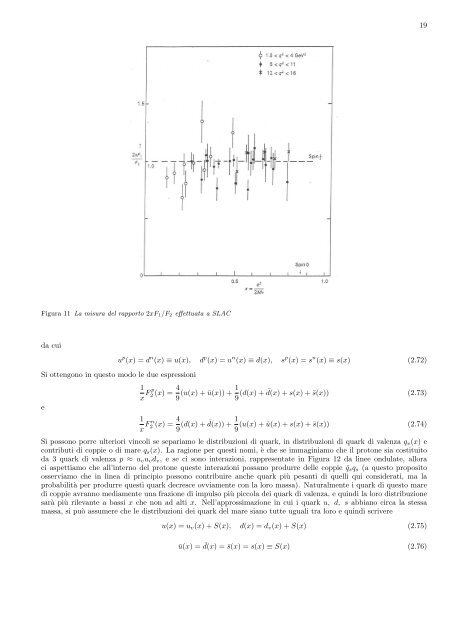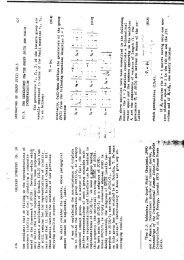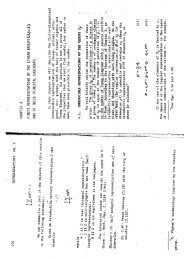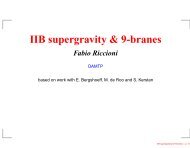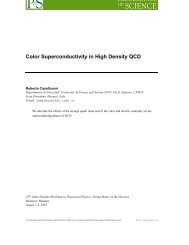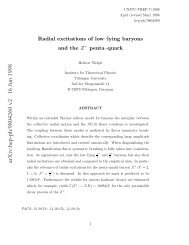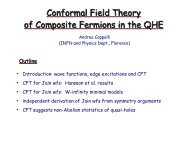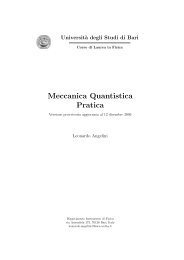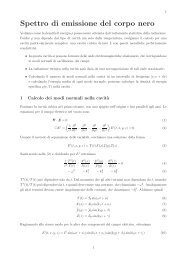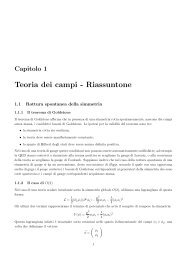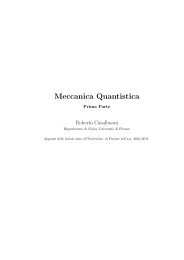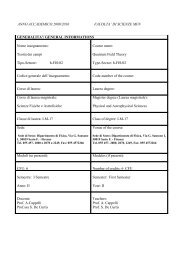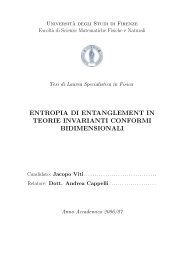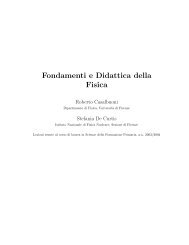Appunti per il corso: Fisica del plasma di quark e gluoni (A.A. ... - Infn
Appunti per il corso: Fisica del plasma di quark e gluoni (A.A. ... - Infn
Appunti per il corso: Fisica del plasma di quark e gluoni (A.A. ... - Infn
Create successful ePaper yourself
Turn your PDF publications into a flip-book with our unique Google optimized e-Paper software.
Figura 11 La misura <strong>del</strong> rapporto 2xF1/F2 effettuata a SLAC<br />
da cui<br />
u p (x) = d n (x) ≡ u(x), d p (x) = u n (x) ≡ d(x), s p (x) = s n (x) ≡ s(x) (2.72)<br />
Si ottengono in questo modo le due espressioni<br />
e<br />
1<br />
x<br />
F p<br />
2<br />
4<br />
1<br />
(x) = (u(x) + ū(x)) +<br />
9 9 (d(x) + ¯ d(x) + s(x) + ¯s(x)) (2.73)<br />
1<br />
x F n 2 (x) = 4<br />
9 (d(x) + ¯ d(x)) + 1<br />
(u(x) + ū(x) + s(x) + ¯s(x)) (2.74)<br />
9<br />
Si possono porre ulteriori vincoli se separiamo le <strong>di</strong>stribuzioni <strong>di</strong> <strong>quark</strong>, in <strong>di</strong>stribuzioni <strong>di</strong> <strong>quark</strong> <strong>di</strong> valenza qv(x) e<br />
contributi <strong>di</strong> coppie o <strong>di</strong> mare qs(x). La ragione <strong>per</strong> questi nomi, è che se immaginiamo che <strong>il</strong> protone sia costituito<br />
da 3 <strong>quark</strong> <strong>di</strong> valenza p ≈ uvuvdv, e se ci sono interazioni, rappresentate in Figura 12 da linee ondulate, allora<br />
ci aspettiamo che all’interno <strong>del</strong> protone queste interazioni possano produrre <strong>del</strong>le coppie ¯qsqs (a questo proposito<br />
osserviamo che in linea <strong>di</strong> principio possono contribuire anche <strong>quark</strong> più pesanti <strong>di</strong> quelli qui considerati, ma la<br />
probab<strong>il</strong>ità <strong>per</strong> produrre questi <strong>quark</strong> decresce ovviamente con la loro massa). Naturalmente i <strong>quark</strong> <strong>di</strong> questo mare<br />
<strong>di</strong> coppie avranno me<strong>di</strong>amente una frazione <strong>di</strong> impulso più piccola dei <strong>quark</strong> <strong>di</strong> valenza, e quin<strong>di</strong> la loro <strong>di</strong>stribuzione<br />
sarà più r<strong>il</strong>evante a bassi x che non ad alti x. Nell’approssimazione in cui i <strong>quark</strong> u, d, s abbiano circa la stessa<br />
massa, si può assumere che le <strong>di</strong>stribuzioni dei <strong>quark</strong> <strong>del</strong> mare siano tutte uguali tra loro e quin<strong>di</strong> scrivere<br />
u(x) = uv(x) + S(x), d(x) = dv(x) + S(x) (2.75)<br />
ū(x) = ¯ d(x) = ¯s(x) = s(x) ≡ S(x) (2.76)<br />
19


